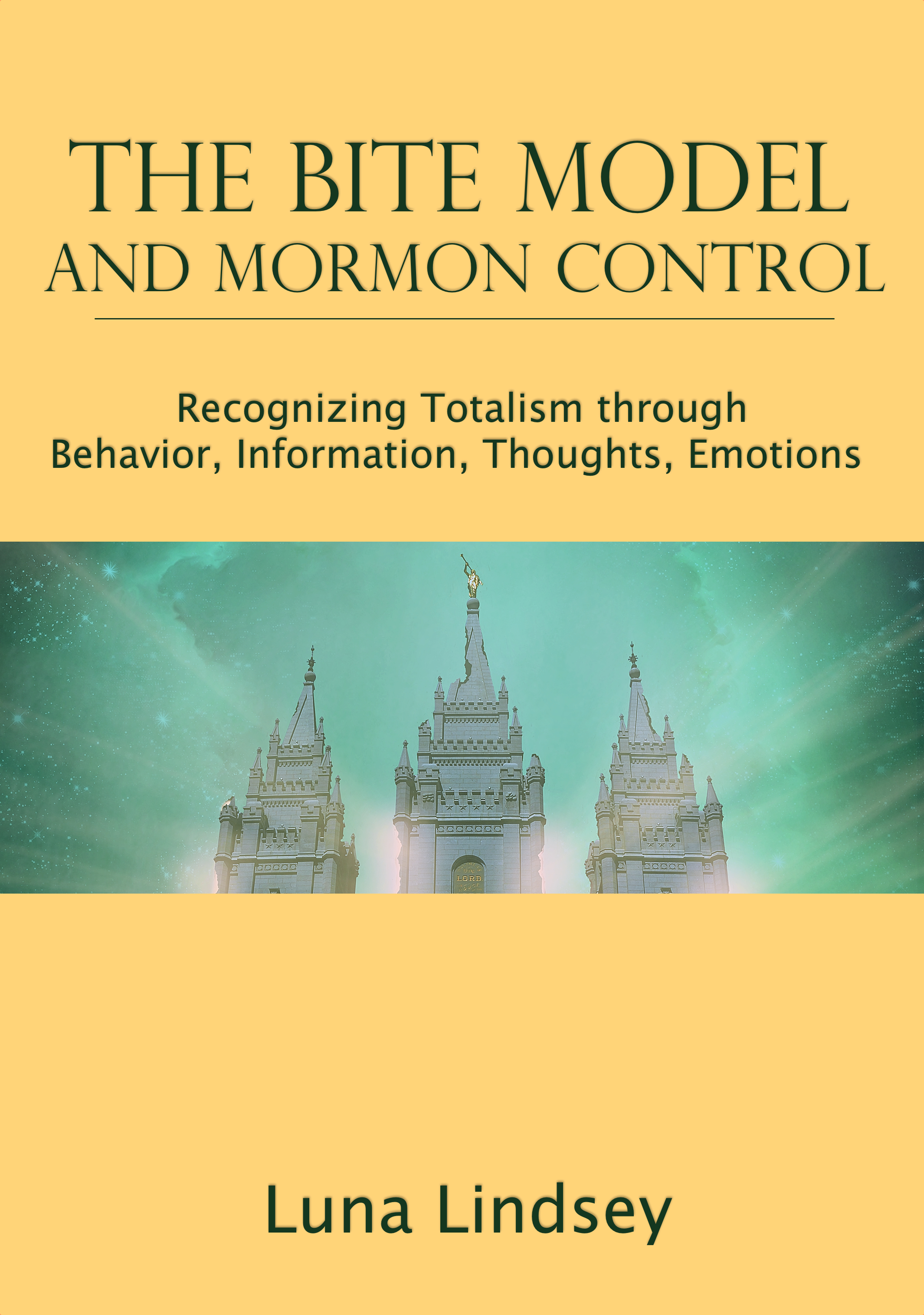“Brainwashing…is an invisible social adaptation. When you are the subject of it, you are not aware of the intent of the influence processes that are going on, and especially, you are not aware of the changes taking place within you.” Cults in Our Midst, Margaret Thaler Singer, p 61
“And they all cried with one voice, saying: Yea, we believe all the words which thou hast spoken unto us; and also, we know of their surety and truth, because of the Spirit of the Lord Omnipotent, which has wrought a mighty change in us, or in our hearts, that we have no more disposition to do evil, but to do good continually.” Mosiah 5:2
Methods of Thought Reform
This is a thorough list of thought reform methods as extracted from multiple books, papers, and web resources. If a detailed description is available, the bullet point will be listed as a link. These descriptions include a summary of the method plus examples from both Mormonism and other groups, where appropriate. All are fully described in more depth in my book, Recovering Agency.
Many of these techniques are interlocked and dependent upon one another. Sometimes it is difficult to tell where one method ends and another begins. The categorization of these methods should be used only as a rough guide for understanding the more complicated dynamics involved.
Not every high-demand group uses all of these methods. Additionally, the degree to which these methods are used can vary from group to group. For instance, one organization may create high levels of physical dependency in its members, while another may only create emotional and spiritual dependency. One group may induce heavy and frequent trance states through the use of meditation, chanting, and hypnosis, while another group may only experience low-level trances on par with those experienced while watching TV or driving.
It should also be pointed out that even within the Mormon experience, the extent and effectiveness of these methods can vary from stake to stake, ward to ward, and family to family. Indeed, the reinforcement or dismissal of doctrines and behaviors on the family level is a huge factor in the Mormon group dynamic. The addition of abuse in a Mormon family can greatly compound the situation, turning what would be a mild cultic experience into a full-blown cult employing every mind control method at high levels.
Psychological Factors:
- Cognitive Dissonance
- Confirmation Bias
- Six Social Compliance Tendencies
Mind Control Techniques:
- Love Bombing – Friendliness, flattery, praise, and affection are used to entice participation and attendance for potential recruits, and to retain members who may be showing less enthusiasm or are thinking of leaving.
- Destabilizing the Self – Barriers are torn down that would otherwise prevent acceptance of new beliefs. Includes those who have already been destabilized by life situations and the indoctrination of children, who have not yet formed a sense of self.
- Deception – Lies, omissions, and “front” activities cover up flaws or unusual aspects of the group, doctrine, leadership, and history. Some deceptions will be revealed later when a member is “ready.”
- Sacred Science (Closed System of Logic) – The ideology and leader have the one and only truth. Members should only seek answers in group teachings. Doctrinal logic is airtight. The leaders are above criticism and those who question or criticize are immoral.
- Mystical Manipulation – Forces exist which are more powerful than the self. The group strives to fulfill a higher purpose. Ends justify the means. Events and experiences are orchestrated, manipulated, or reframed to appear supernatural and prove the leader is chosen and the doctrines are true.
- Milieu Control – Information and environment are tightly controlled. Gossip, questioning, and criticism is tightly regulated, as is access to outside information, especially that which might raise doubts or be critical of the group.
- Demand for Purity (Perpetual Inadequacy) – Lofty moral goals are set. At first the goals seem achievable, but the standards for achievement grow ever more impossible to meet, keeping the follower perpetually inadequate.
- Dispensing of Existence – The individual’s literal or figurative existence is threatened as a consequence for impurity, doubt, or leaving the group. Life, the eternal soul, self-esteem, a sense of “being good”, and one’s identity hangs in the balance.
- Doctrine Over Self – The individual is subordinate to the group, leader, and teachings. When personal desires, goals, and values conflict with group values, they become selfish or immoral.
- Loading the Language – Existing words are loaded with new meaning. New words are added. Other words are banned or dropped from usage. This affects ability to think, as well as ability to communicate comfortably with those outside the group.
- Totalist Reframing – Situations, thoughts, or feelings are reinterpreted in a way that suits the goals of the organization. This is used to continually prove the ideology correct, to squelch doubts, and to silence outsiders.
- Thought-Terminating Clichés – Short phrases, pat answers, metaphors, and emotional reactions are pre-established to frame doubts. Doubt and questions are automatically shut down.
- Social Pressure – Social acceptance and rejection are used to reward and punish. A member becomes driven with a desire to conform.
- Belief Follows Behavior – Action generates the associated beliefs.
- Public Commitment – Commitments are expressed aloud. Public statements reinforce belief and dedication to the group.
- Creating Dependency – A member comes to depend on the group for physical, emotional, social, spiritual, or other needs. The member has a high stake in continuing to stay loyal to the group.
- Black and White Thinking – Broad spectrums of thought and morality become reduced to two options: Good vs. Evil, Love vs. Hate, Weak vs. Strong. Humble vs. Proud.
- Elitism – The members of the group are chosen people, exalted, righteous. Members are made to feel special when compared to outsiders.
- Us-Versus-Them Thinking – This is a form of black-and-white thinking wherein outsiders, ex-members, and those critical of the group are dehumanized and labeled as evil, apostate, vicious, hateful, prideful, blinded, deceived, etc. A persecution complex may exist whereby reasonable criticism is reframed as an attack.
- Indirect Directives – Certain restrictions or demands on behavior are implied rather than express. The logical elements for a given conclusion are supplied, leaving the member to draw the conclusion herself. Leadership remains innocent of issuing any unseemly teachings.
- Identification and Example – Those who behave correctly or incorrectly are used as examples. Suggested behavior can be inferred from these stories without direct commandment. Stories are told, which may be reframed or blatantly untrue, to demonstrate consequences. The human mind relates strongly to stories, and it also inspires social pressure.
- Emotion Over Intellect – Emotion is emphasized as the preferred decision-making tool. The value of using reason is downplayed. Doctrines are frequently taught in emotional contexts, such as through stories told in tearful or gentle tones.
- Induced Phobias – Fears are instilled which are either imaginary, based on real or exaggerated consequences, or on artificial effects created from group pressures.
- Trance Induction & Dissociative States – Critical thinking skills are reduced through regular encouragement of receptive mental states. Altered states can be mild and seem normal, and include concentration, fatigue, boredom, and hunger.
- Time Control – The member has little time or energy to question beliefs, associate with outsiders, or examine life too closely. Time spent on group-related activities is strongly encouraged or enforced, and usually fills every spare moment.
- Double-Bind – The member is “damned if you do, damned if you don’t.” She must betray the group or betray her own integrity.
- Blame Reversal – The leadership, group, and doctrine are above reproach, so any failed promises and bad situations are always the fault of the member.
- Guilt & Shame – A cycle of guilt and shame comes from repressed doubts, social pressure, and failure to meet impossible standards.
- Confession – The individual surrenders to leaders through confession, which reduces privacy and boundaries. Successful purification can grant temporary relief from guilt, which increases trust and dedication. Members are motivated to obey to avoid confession.
- Euphoria Induction – The euphoria of group participation and fulfilling the member’s ideals motivates good behavior and reduces doubts while proving the validity of the group.
- Proselytizing – Members are encouraged to propagate teachings to outsiders. This not only maintains or increases the size of the group, but also soothes cognitive dissonance, consumes time, and provides opportunities for public commitment.
Jonathan Streeter created a beautiful visual glossary of these concepts, Glossary of Undue Influence.
Read more about the Methods of Thought Reform in my book, Recovering Agency: Lifting the Veil of Mormon Mind Control.



